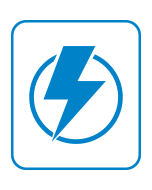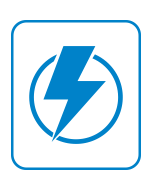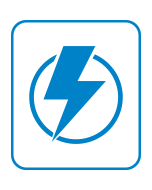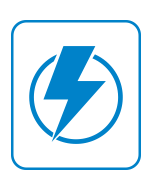Global Li-ion Battery Materials Growth Opportunities
Global Li-ion Battery Materials Growth Opportunities Updated Research Available
Advanced Battery Materials are Key to Meeting the Future Growth Potential of Li-ion Batteries
12-Jul-2021
Global
$4,950.00
Special Price $3,712.50 save 25 %
Description
This study quantifies the consumption of key lithium-ion (Li-ion) battery materials and focuses on gauging the impact that key market developments, like the advancements in battery chemistries, the rapid increase in electric vehicle (EV) sales, an ever-tightening regulatory scenario, and a shift in consumer preferences towards EVs, etc., are expected to have on the demand for individual materials between 2020 and 2027.
The study (an update of Frost & Sullivan’s study on Li-ion battery materials, published in 2020) quantifies the consumption of key material types, namely cathode materials, anode materials, electrolytes, separators, binders, and adhesives & sealants. On the basis of applications, the study analyses the demand for battery materials from applications such as EVs, industrial and energy storage systems (ESS), consumer electronics, and others (medical & healthcare devices and portable tools). The study quantifies the consumption of each of these material types on the basis of a robust methodology comprising an analysis of total Li-ion battery production, EV production volumes, uptake of the considered materials, and supply of those materials.
After having registered a lackluster growth in 2019, the global EV sales registered a sharp surge (+35% y-o-y) in 2020. The global EV sales (BEVs and PHEVs) nearly quadrupled between 2016 and 2020. The global EV sales volume was estimated at nearly 3.1 Mn units for 2020. This is despite the raging pandemic, ensuing containment measures, and supply disruptions, and in sharp contrast with the internal combustion engine (ICE) vehicle sales that plummeted by 14% in 2020. As the demand gathers momentum and as more and more large global-scale battery facilities come online, production costs and average price are expected to register further declines, thereby inching closer to the coveted tipping point, where the gap between ICE vehicles and EVs disappears.
On the flip-side, while the global EV sales have been registering a robust growth, especially for the last 3 to 5 years, the bulk of the sales volume has been concentrated in the United States, China, and Western Europe. However, EVs currently available in countries such as India and Brazil are priced significantly higher than conventional mass-market ICE vehicles. Furthermore, the lack of a well-developed network of charging infrastructure in these regions is likely to continue to compound the impediments associated with the mass adoption of EVs, at least over the short term.
The continued push towards longer-range vehicles (and hence higher energy density batteries) entails a shift towards technologies based on higher nickel content cathode chemistry, partial replacement of graphite with silicon composites in anodes, the incorporation of functional additives in electrolytes, and increasing demand for thinner, high thermal resistance separators.
While battery manufacturers are focusing on increasing capacity and reducing costs, a disruption in the supply of any of these crucial chemicals results in sky-rocketing prices and availability concerns, thereby disrupting the entire value chain. This is exacerbated by other diverse concerns ranging from ethical sourcing (artisanal or small-scale subsistence mining, child labor) to political instability in countries such as the Democratic Republic of Congo (DRC)—the single largest supplier of cobalt. Accordingly, incumbents across the value chain, especially in Europe, are increasingly mandating the ethical sourcing of raw materials, reducing the use of critical materials, and developing processes and infrastructure for the recycling and end-of-life management for Li-ion batteries.
Frost & Sullivan analysis indicates that the global battery materials market is slated to register a robust double-digit growth of about 15.6% in terms of revenue between 2020 and 2027.
Author: Gautam Rashingkar
RESEARCH: INFOGRAPHIC
This infographic presents a brief overview of the research, and highlights the key topics discussed in it.Click image to view it in full size
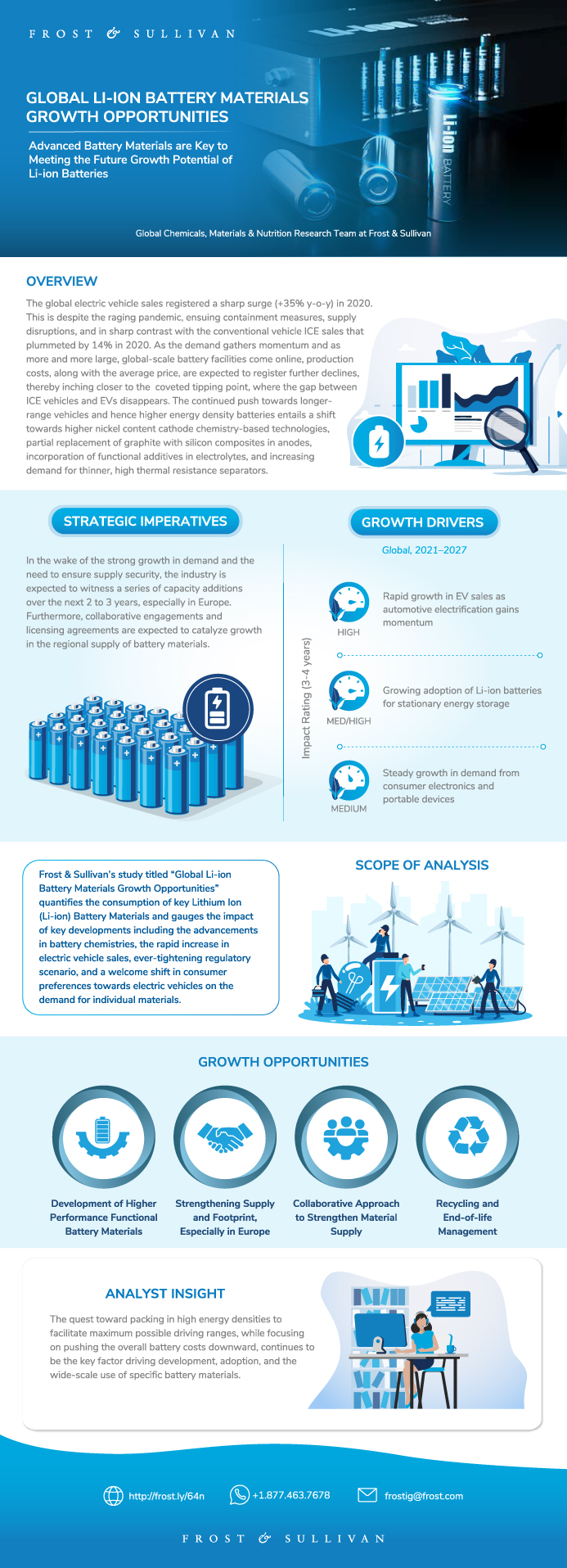
Table of Contents
Why Is It Increasingly Difficult to Grow?
The Strategic Imperative 8™
The Impact of the Top three Strategic Imperatives on the Li-ion Battery Materials Market
Growth Opportunities Fuel the Growth Pipeline Engine™
Li-ion Battery Materials Market—Scope of Analysis
Li-ion Battery Materials Market Segmentation
Li-ion Battery Materials Market Segmentation (continued)
Market Definitions
Market Definitions (continued)
Market Definitions (continued)
Market Definitions (continued)
Market Definitions (continued)
Market Overview and Scope
Market Overview and Scope (continued)
Market Overview and Scope (continued)
Li-ion Batteries—Cost Composition
Market Overview
Key Growth Metrics for Li-ion Battery Materials Market
Growth Drivers for Li-ion Battery Materials Market
Growth Driver Analysis for Li-ion Battery Materials Market
Growth Driver Analysis for Li-ion Battery Materials Market (continued)
Growth Driver Analysis for Li-ion Battery Materials Market (continued)
Growth Driver Analysis for Li-ion Battery Materials Market (continued)
Growth Restraints for Li-ion Battery Materials Market
Growth Restraint Analysis for Li-ion Battery Materials Market
Growth Restraint Analysis for Li-ion Battery Materials Market (continued)
Growth Restraint Analysis for Li-ion Battery Materials Market (continued)
Challenges and/or Opportunities for Material Suppliers
Drivers and Restraints—Impact Assessment
Drivers and Restraints—Impact Assessment (continued)
Forecast Assumptions—Li-ion Battery Materials Market
Revenue Forecast—Li-ion Battery Materials Market
Revenue Forecast Analysis—Li-ion Battery Materials Market
Revenue Forecast by Material Type—Li-ion Battery Materials Market
Volume and Revenue Forecast Analysis—Li-ion Battery Materials Market
Volume and Revenue Forecast Analysis—Li-ion Battery Materials Market (continued)
Volume and Revenue Forecast Analysis—Li-ion Battery Materials Market (continued)
Attractiveness Analysis by Material Type—Li-ion Battery Materials Market
Battery Technology and Materials Evolution Timeline
Applications Overview
Revenue Forecast by Application—Li-ion Battery Materials Market
Revenue Forecast Analysis by Application—Li-ion Battery Materials Market
Revenue Forecast Analysis by Application—Li-ion Battery Materials Market (continued)
Attractiveness Analysis by Application—Li-ion Battery Materials Market
Revenue Forecast by Region—Li-ion Battery Materials Market
Revenue Forecast Analysis by Region—Li-ion Battery Materials Market
Revenue Forecast Analysis by Region—Li-ion Battery Materials Market (continued)
Revenue Forecast Analysis by Region—Li-ion Battery Materials Market (continued)
Attractiveness Analysis by Region—Li-ion Battery Materials Market
Value Chain—Li-ion Battery Materials Market
Value Chain Analysis—Li-ion Battery Materials Market
Li-ion Battery Manufacturing Process Overview
List of Material Suppliers by Type
List of Material Suppliers and Battery Manufacturers
Revenue Share—Li-ion Battery Materials Market
Competitive Environment—Li-ion Battery Materials Market
Characteristics and Overview—Cathode Materials
Characteristics Comparison—Cathode Materials
Specifications Comparison—Cathode Materials
Material Selection Criteria for Applications—Cathode Materials
Key Features—Cathode Materials
Presence in Applications—Cathode Materials
Trends—Cathode Materials
Trends—Cathode Materials (continued)
Trends—Cathode Materials (continued)
Key Growth Metrics for Cathode Materials
Revenue and Volume Forecast—Cathode Materials
Volume and Revenue Forecast Analysis—Cathode Materials
Pricing Trends and Forecast—Cathode Materials
Pricing Trends and Forecast Analysis—Cathode Materials
Volume Forecast by Chemistry—Cathode Materials
Volume Forecast Analysis by Chemistry—Cathode Materials
Attractiveness Analysis by Chemistry—Cathode Materials
Competitive Environment—Cathode Materials
Characteristics and Overview—Anode Materials
Characteristics Comparison—Anode Materials
Trends—Anode Materials
Trends—Anode Materials (continued)
Key Growth Metrics for Anode Materials
Revenue and Volume Forecast—Anode Materials
Volume and Revenue Forecast Analysis—Anode Materials
Pricing Trends and Forecast—Anode Materials
Pricing Trends and Forecast Discussion—Anode Materials
Volume Forecast by Chemistry—Anode Materials
Volume Forecast Analysis by Chemistry—Anode Materials
Attractiveness Analysis by Chemistry—Anode Materials
Competitive Environment—Anode Materials
Characteristics and Overview—Electrolytes
Materials Overview—Electrolytes
Materials Overview—Electrolytes (continued)
Lithium Salts—Properties Comparison: Electrolytes
Noteworthy Developments—Electrolytes
Trends—Electrolytes
Key Growth Metrics for Electrolytes
Revenue and Volume Forecast—Electrolytes
Volume and Revenue Forecast Analysis—Electrolytes
Pricing Trends and Forecast—Electrolytes
Pricing Trends and Forecast Analysis—Electrolytes
Competitive Environment—Electrolytes
Characteristics and Overview—Separators
Key Parameters—Separators
Wet and Dry Process Separators Comparison—Separators
Wet Process and Dry Process Flow—Separators
Trends—Separators
Key Growth Metrics for Separators
Revenue and Volume Forecast—Separators
Volume and Revenue Forecast Analysis—Separators
Pricing Trends and Forecast—Separators
Pricing Trends and Forecast Analysis—Separators
Volume Forecast by Process—Separators
Volume Forecast Analysis by Process—Separators
Attractiveness Analysis by Process—Separators
Competitive Environment—Separators
Characteristics and Overview—Binders
Definition and Characteristics—Binders
Materials and Composition—Binders
Materials and Composition—Binders (continued)
Cathode Binders—PVDF
Anode Binders—SBR/CMC
Binder Materials—Trends
Key Growth Metrics for Binders
Revenue and Volume Forecast—Binders
Volume and Revenue Forecast Analysis—Binders
Pricing Trends and Forecast—Binders
Pricing Trends and Forecast Analysis—Binders
Volume Forecast by Chemistry—Binders
Volume Forecast Analysis by Chemistry—Binders
Volume Forecast by Application—Binders
Volume Forecast Analysis by Application—Binders
Competitive Environment—Binders
Competitive Environment
Characteristics and Overview—Adhesives & Sealants
Characteristics and Overview—Adhesives & Sealants (continued)
Key Growth Metrics for Adhesives & Sealants
Revenue and Volume Forecast—Adhesives & Sealants
Volume and Revenue Forecast Analysis—Adhesives & Sealants
Pricing Trends and Forecast—Adhesives & Sealants
Pricing Trends and Forecast Analysis—Adhesives & Sealants
Volume Forecast by Application—Adhesives & Sealants
Volume Forecast Analysis by Application—Adhesives & Sealants
Attractiveness Analysis by Application—Adhesives & Sealants
Competitive Environment—Adhesives & Sealants
Growth Opportunity 1—Development of Higher Performance Functional Battery Materials
Growth Opportunity 1—Development of Higher Performance Functional Battery Materials (continued)
Growth Opportunity 2—Strengthening Supply and Footprint, Especially in Europe
Growth Opportunity 2—Strengthening Supply and Footprint, Especially in Europe (continued)
Growth Opportunity 3—Collaborative Approach to Strengthen Material Supply
Growth Opportunity 3—Collaborative Approach to Strengthen Material Supply (continued)
Growth Opportunity 4—Recycling and End-of-life Management
Growth Opportunity 4—Recycling and End-of-life Management (continued)
Your Next Steps
Why Frost, Why Now?
Abbreviations and Acronyms Used
List of Exhibits
List of Exhibits (continued)
List of Exhibits (continued)
List of Exhibits (continued)
List of Exhibits (continued)
List of Exhibits (continued)
Legal Disclaimer
Popular Topics
| No Index | No |
|---|---|
| Podcast | No |
| Predecessor | MF51-39 |
| Author | Gautam Rashingkar |
| Industries | Chemicals and Materials |
| WIP Number | MG10-01-00-00-00 |
| Is Prebook | No |
| GPS Codes | 9100-A2,9869-A2,9595,9870 |
 USD
USD GBP
GBP CNY
CNY EUR
EUR INR
INR JPY
JPY MYR
MYR ZAR
ZAR KRW
KRW THB
THB
